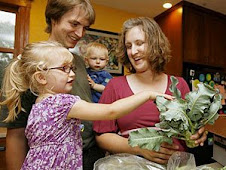When we were about to being our year, I called our local processing plant (Mueller-Pinehurst) which is right here in Rockford and, after being transferred to several people who could not answer my questions, I was finally connected with someone who could. He explained to me that the milk they process in Summer is indeed local, the demand can be met by dairies within 100 miles. However, he did tell me that not all of their dairy products are produced at their local plant. Milk in gallon jugs and (I believe) buttermilk are locally-produced. As is anything stamped with 12-274 (the local plant number). However, their milk in half-gallon jugs and their cottage cheese and (I think) sour cream are not made here or are not made with local milk.
He went on to tell me that in Winter, the demand for milk and dairy products rises. This makes sense as we think of winter as the time for comfort foods and cream soups while we'd probably rather drink iced tea on a hot summer day. Anyway, in the winter the increased demand is unable to be met by local dairies and so a portion (I did not ask him for a percentage) of the milk processed at the local plant is brought in from farther away.
When we began our challenge in June, I was content to purchase Mueller-Pinehurst milk but by September I was seeking other options, knowing that my all-local source would soon "run out." I was lucky to be able to connect with a group of people who are shareholders in cows. That's right, we buy a share of a cow and in return we receive a percentage of the milk that "our" cow produces. So, since September, we have been getting milk this way. Also, a great little grocery store called Bushel and Peck's opened up this summer in Beloit (BushelandPecks.com). They sell single-source milk from southern Wisconsin under the brand name Sassy Cow. They also have Wisconsin milk in returnable glass bottles that's great but not guaranteed to be only from within 100 miles of Rockford (not good for me but great for the rest of you!).
Lucky for me, my current sources for milk are all organic (Mueller-Pinehurst was not) and not Ultra-Pasteurized (UP) so more of the nutrients are left in the milk (both due to lower-heat pasteurization and a shorter cold storage period). Also, I am able to use this milk to make cheese which one cannot do with UP or even high-temperature-pasteurized milk. Just today I received an e-newsletter from the company where I buy my cheese-making supplies that had an article that did a good job of detailing the changes in milk over the last generation or two. I'll excerpt it here and include the link to the full article:
Full Article "More About Milk" from Cheesemaking.com
According to several conversations with milk processors across the country during the past 2 years we have become aware of a tendency for regulating agencies to strongly suggest increasingingly higher pasteurization temperatures. This issue of higher pasteurizing temps and times seems to be an attempt to eliminate Johne's (pronounced yo-neez) disease (Mycobacterium .Paratuberculosis) from our milk supply. This disease has increased in recent years and seems to be most serious in the larger industrial herds.
The tendency has been to increase pasteurization temps to 174-180F plus and increase the hold times for this.
This is in spite of research done in Ireland and at Guelph Ontario showing that traditional vat pasteurization of 145F/30min totally eliminates the bacteria and that HTST [high temperature short time] pasteurization 163F/16secs shows small numbers in the milk. Further research is being done on holding at 163F but increasing the times. The research has also shown that exposing the milk to a higher temperature would not be a good option because a higher temperature could be detrimental to its nutritional value.
Rather than trying to force industrial dairies to clean up their act in order to improve the health of their herds, the FDA has put its support behind higher-temperature pasteurization.











